This recipe is an excerpt from my cookbook Sabai which is all about weeknight friendly Thai recipes.
For years I’ve been preaching about the fact that 99% of satays in Thailand are pork satay, NOT the chicken version popular in Thai restaurants in America. But it occurred to me that if you’re going to cook boneless, skinless chicken breasts one way or another, the satay treatment is one of the best things you can do to this otherwise unexciting protein.
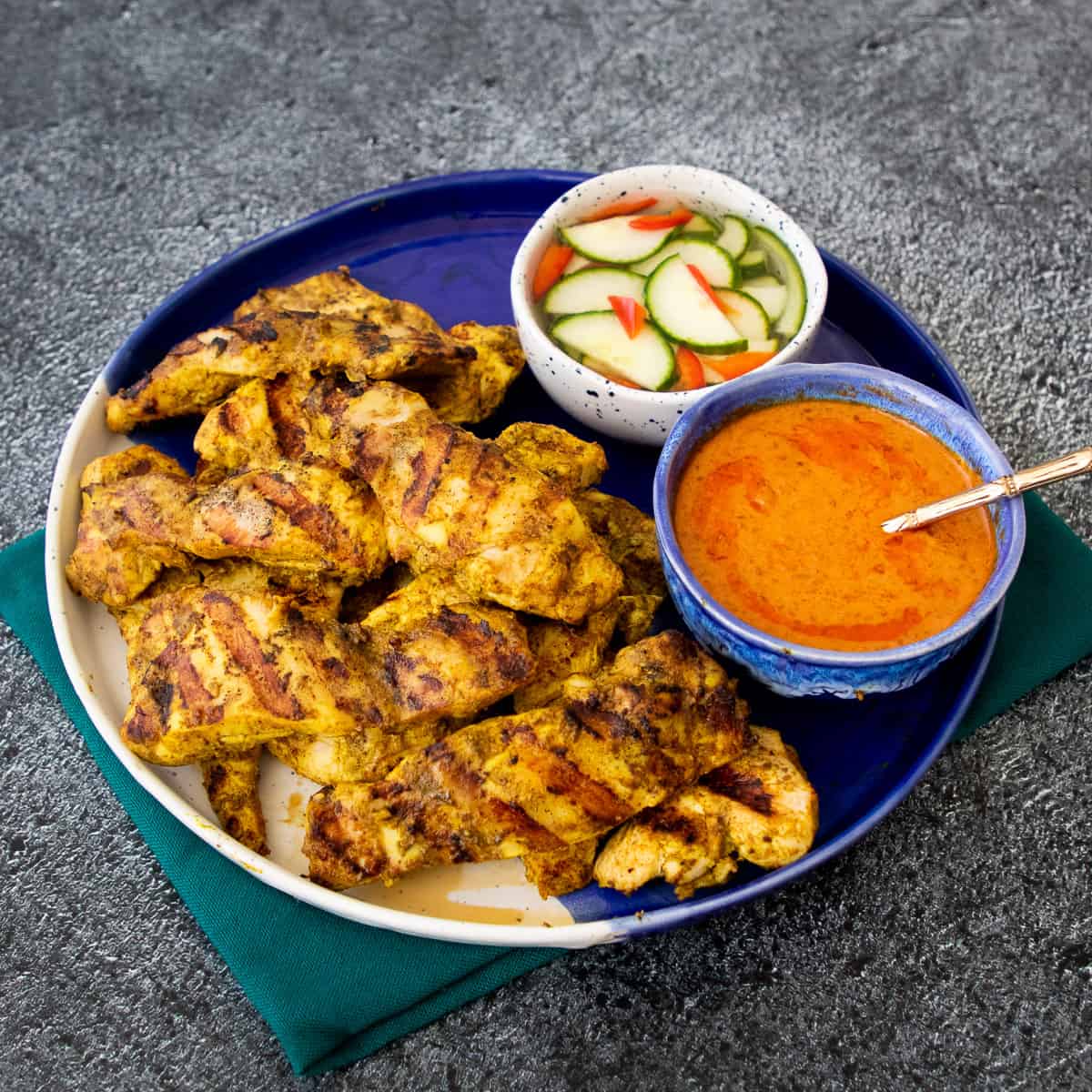
To make it weeknight friendly, I’ve omitted the most dreaded part of making satay, the skewering. Just throw the chicken on the grill if you have one, or cook it indoors using a grill pan or a saute pan. It works as an appetizer or as the main dish. The dipping sauce, which is the “real” Thai peanut sauce, can be made in advance, and will last in the fridge for at least a week.
What is satay exactly?
Satay refers to skewered marinated meats that are grilled and served with a peanut dipping sauce. Satay came to Thailand from Indonesia, and originally it arrived as beef satay. But in Thailand, pork is the more common meat; so eventually pork satay became the most popular and basically the only kind of satay we eat.
But outside of Thailand in Thai restaurants, it’s a different story. Pork is much less popular and chicken is king (and the cheapest!). So restaurants overseas chose to use chicken instead, and that’s how chicken satay became associated with Thai food; even though you can barely find it in in Thailand!
What is satay sauce? Is it the same as peanut sauce?
The sauce traditionally served with Thai satay is a spicy peanut sauce and coconut milk, flavoured with Thai red curry paste. I call this a peanut sauce, but really it should be called satay sauce because it is a sauce that is ONLY served with satay.
We don’t make bottles of this peanut sauce and just put it on random stuff. In fact, there is no such thing as a generic “Thai peanut sauce” made from peanut butter that we use like it were ketchup. Peanut butter is not even a Thai ingredient!
So the next time you see a “creamy Thai peanut sauce recipe” on the internet made with peanut butter and soy sauce, you now know that it’s nonsense.
*Note that the Thai satay sauce is different from Indonesian satay sauce – naturally foods change as they travel to new destinations.
No Skewers Needed
Followers of the show may know that I hate skewering. I really do…due in part to my having skewered hundreds of various foods during my years in the catering and restaurant industry.
So because I wanted this to be an easy chicken satay recipe, and not one that requires messy fiddling with bamboo skewers while occasionally stabbing yourself, I have left out the skewering. What’s the point of skewers anyway if we’re not selling these on the street? I can use a fork, thank you.
Ingredients
Here are all the ingredients for chicken satay. It only looks like a long list, but many of these are pantry staples, and there’s really not much shopping to do! For amounts, see the full recipe card below.
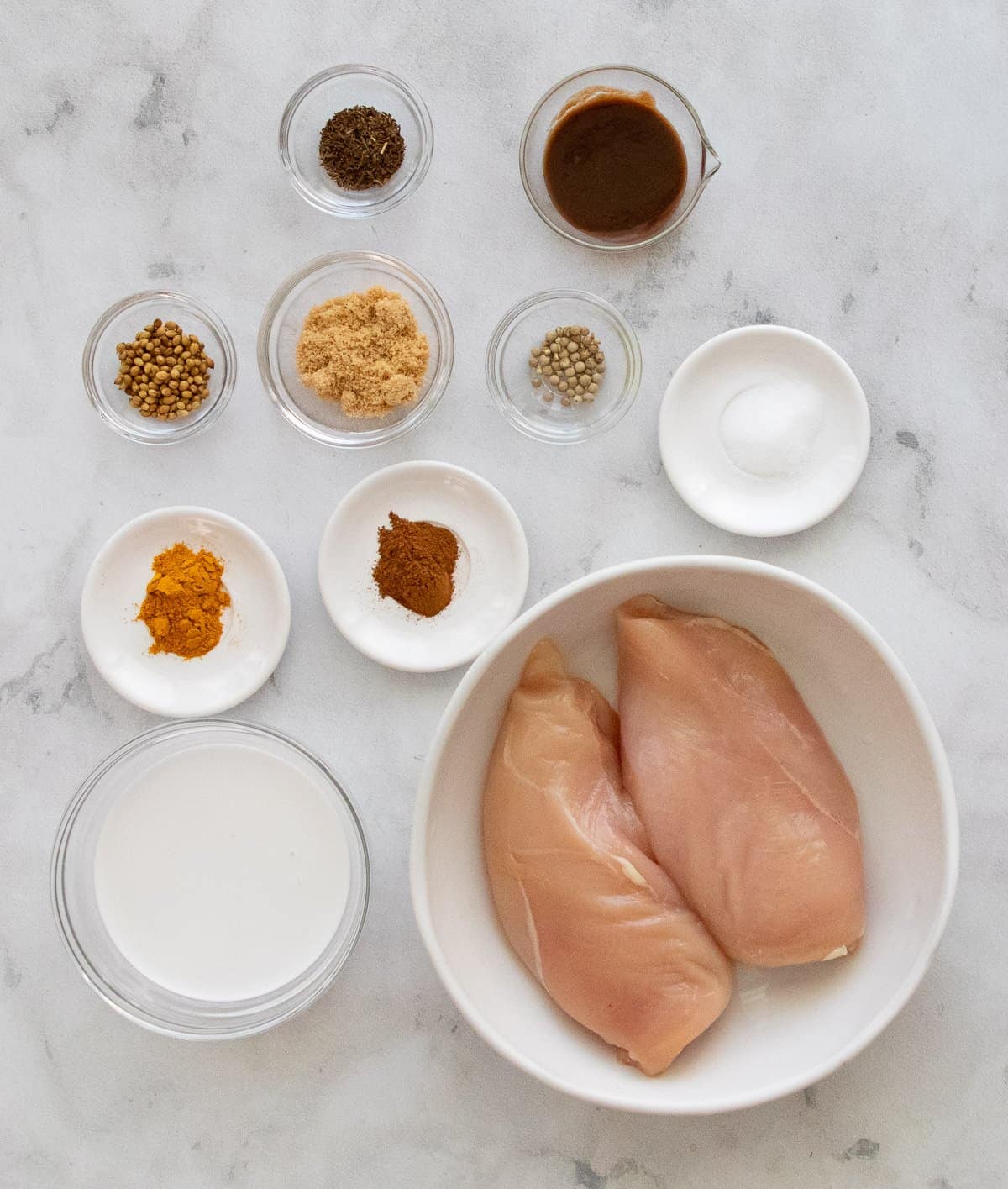

MARINATED CHICKEN
The chicken can be marinated up to one day in advance; but if you’re in a rush, just let them sit while you make the peanut sauce. A minimum of 20 minutes is ideal.
- coriander seeds, preferably toasted, but if you’re lazy it’s fine not to.
- cumin seeds, also preferably toasted.
- white peppercorns
- brown sugar
- salt
- ground turmeric
- ground cinnamon
- tamarind paste, store-bought or homemade
- coconut milk
- boneless skinless chicken breasts or thighs. I suggest seeing the video tutorial for a demo for how I cut chicken so it’s clear, but for breasts, cut into long ½-inch thick strips diagonally against the grain. For thighs, trim off the fat and any dangly bits, then cut in half lengthwise.
- Jasmine rice and/or white toast, for serving, and optional. If you want to serve these as an appy, eating it with white toast is actually a classic in Thailand! But to make this a meal you can serve with rice.
THAI PEANUT SAUCE
This peanut sauce is the real deal. None of that peanut butter-laden stuff; which if you didn’t know, is a totally Americanized invention. This sauce will last at least a week in the fridge so make it ahead of time if you wish. It will also freeze beautifully if you want to make a whole bunch.
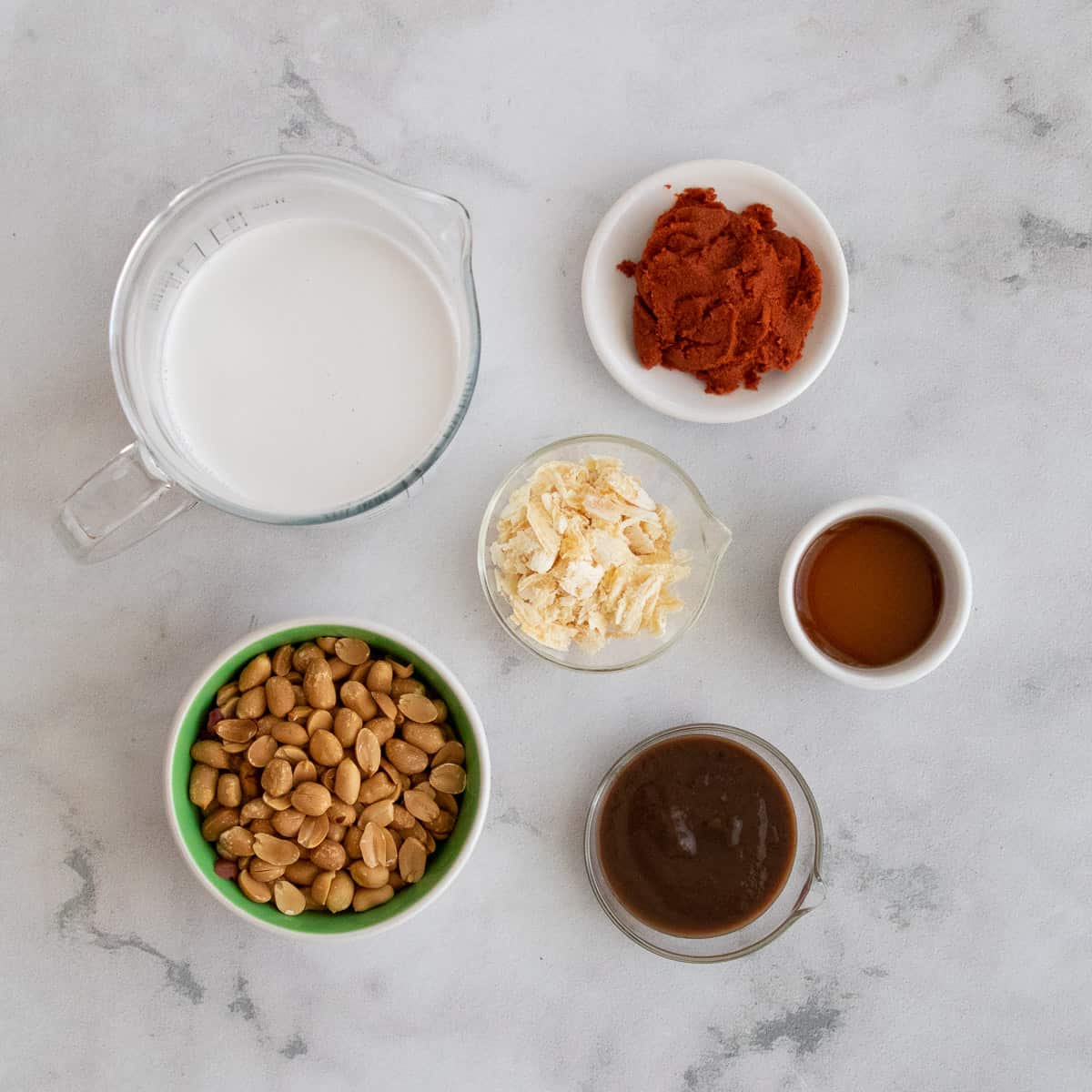

- roasted peanuts, unsalted. I always buy raw peanuts and roast them myself because the flavour is just superior to pre-roasted peanuts. I also buy skin-on peanuts because they, too, taste better despite a lot of work to skin them after. Roast them in a 350°F oven for about 15-20 minutes (timing depends on the size) until they’re lightly browned.
- coconut milk
- Red curry paste, see this post for my review of store-bought brands. You can also make your own red curry paste and freeze!
- tamarind paste, store-bought or homemade
- Palm sugar
- fish sauce
“AJAAD” QUICK CUCUMBER PICKLE (optional)
This is what I call an “instant pickle” that you can serve right after you make it. It is served with satay to help cut the richness of the rich peanut sauce, but it’s up to you if you want to leave it out. You can also serve the satay with any other tart pickles you’ve got in your fridge.
- white vinegar, or you can use rice vinegar, Filipino cane vinegar, or any kind of mild-flavoured vinegar.
- granulated sugar
- salt
- cucumber
- Thai chilies or another hot pepper (optional)
How to Make Thai Chicken Satay
Here’s a bird’s eye view of the process. The full instructions are in the recipe card below. If this is your first time, I recommend watching the full video tutorial to ensure success!


- Pound the coriander, cumin and white peppercorns into a powder.
- Add all remaining marinade ingredients and mix well. Transfer to a mixing bowl.
- Cut the chicken breast against the grain, diagonally, into ½-inch thick strips. Once you get to the flat part of the chicken, you can make it wider to even out the size. For chicken thighs, trim off excess fat and any dangly bits and cut horizontally in half. (See video for a visual of how to do this.)
- Mix well with the marinade and let sit for at least 20 minutes and up to one day. Meanwhile make the peanut sauce.


- Grind the peanuts until mealy in a food processor or mortar and pestle. Do not turn them into peanut butter!
- Cook ⅓ cup of the coconut milk with the red curry paste until thick, and the coconut oil starts to separate out from the paste.
- Add the remaining coconut milk, the peanuts, tamarind and palm sugar and cook for about 5 minutes until it’s thick.
- Taste the sauce and add fish sauce as needed. If you want to serve with pickles, make the pickling liquid now; instructions are in the recipe card, but you simply have to dissolve the sugar and salt in the vinegar and let it cool!
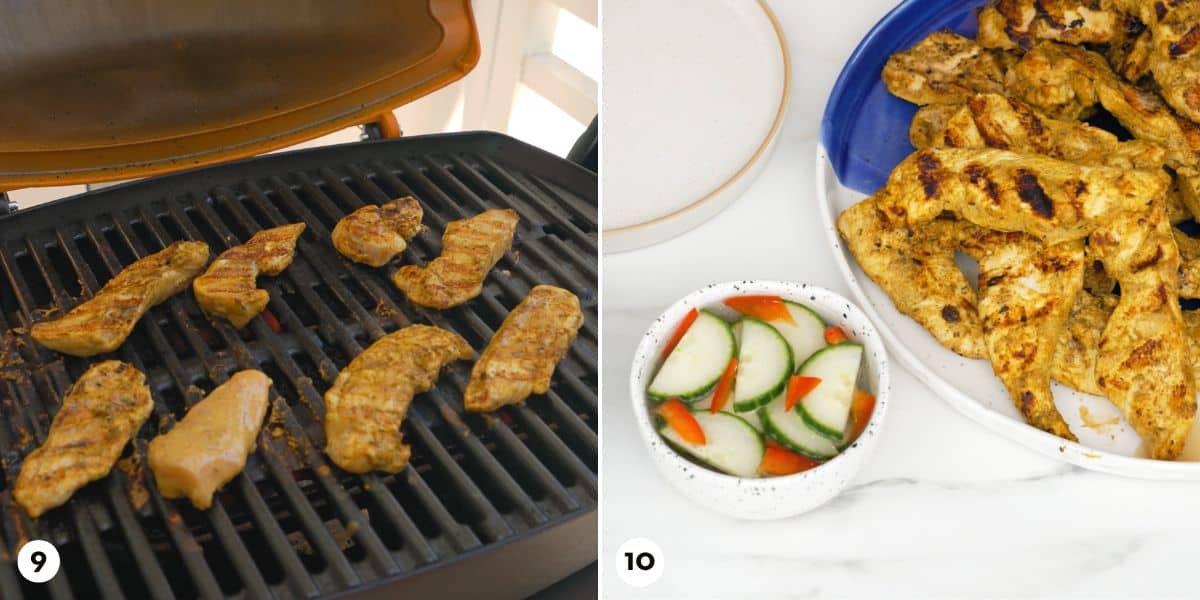

- Grill the chicken breast for a few minutes per side with the lid open. If using chicken thighs, you may close the lid as they tend to take longer. You can also pan sear the chicken on a nonstick skillet instead.
- If serving with the instant pickle, pour the pickling liquid over the cucumber shortly before serving so the cucumber remains crisp.
FAQ
The chicken can be marinated up to one day in advance, and the peanut sauce will last at least a week in the fridge.
See these recipes for pork satay and beef satay. Each protein requires slightly different preparation and cooking, though the sauce and the marinade is basically the same.
You can substitute extra firm tofu for the meat and use soy sauce instead of fish sauce. The peanut sauce is so flavourful it will make the tofu super tasty!
You can pan fry the chicken instead in a non-stick skillet, and the full instructions are in the recipe card. You’ll need to do it in batches so as to not crowd the pan. You may also need to wipe the pan with paper towel between batches to prevent any remaining marinade from burning.
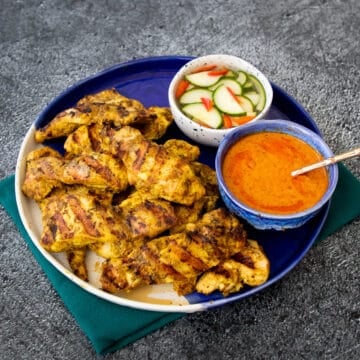

Easy Thai Chicken Satay & Peanut Sauce
Skip the skewering and have flavourful chicken satay with authentic Thai peanut sauce any night of the week. Grill the chicken, or simply broil or pan fry it indoors.
Ingredients
“AJAAD” QUICK CUCUMBER PICKLE (OPTIONAL)
Check Out Ingredients and Kitchen Tools I Use
Notes
- See the video tutorial for how I cut the chicken breast for maximum tenderness and evenness. If using chicken thighs, trim off any excess fat and remove the “oyster” (the chunky, dangly bit) for more even thickness, then cut the piece in half lengthwise.
All my recipes come with step-by-step video tutorials with extra tips not mentioned in the blog post, so make sure you watch the video to ensure success. If you enjoy them, consider subscribing to the YouTube Channel to not miss an episode. Thank you!
Subscribe to my YouTube Channel
Instructions
-
Grind the coriander seeds, cumin seeds, and peppercorns in a coffee grinder or mortar and pestle until very fine, then transfer to a mixing bowl. Add the brown sugar, salt, turmeric, cinnamon, tamarind paste, and coconut milk; stir to mix well.
1½ teaspoons coriander seeds, ½ teaspoon cumin seeds, ½ teaspoon white peppercorns, 1 tablespoon brown sugar, ¾ teaspoon table salt, ¾ teaspoon ground turmeric, ½ teaspoon ground cinnamon, 1 tablespoon tamarind paste, ½ cup coconut milk
-
Add the chicken to the marinade and mix very well to ensure all the pieces are coated. Marinate at room temperature for 20 minutes or cover and refrigerate for up to 1 day. The longer it marinates, the better— just stir it once or twice during the marinating time.
1.2 lb boneless skinless chicken breasts
FOR THE PEANUT SAUCE
-
Using a mortar and pestle or a food processor, grind the peanuts until mealy. If using a machine, be careful not to turn this into peanut butter; you want texture in the peanut sauce.
½ cup roasted peanuts
-
Put about ⅓ cup (80 ml) of coconut milk in a small pot and bring to a boil over medium heat. Add the curry paste and cook for about 3 minutes, stirring constantly until the mixture is very thick and the coconut oil starts to separate from the paste (the oil may not separate depending on the coconut milk you’re using; this is okay )
1¼ cups coconut milk, 2 tablespoons red curry paste
-
Add the remaining coconut milk and stir to mix well. Add the peanuts, tamarind paste, and palm sugar, and simmer gently for 5 minutes, stirring frequently, until thickened into a dip consistency. Be sure to scrape the bottom of the pot when stirring to prevent scorching. If the sauce gets too thick before 5 minutes of cooking time is up, add a splash of water so that you can give it the full 5 minutes to develop the flavor.
2 tablespoons tamarind paste, 2 tablespoons finely chopped palm sugar, 1-2 teaspoons fish sauce
-
Taste and add fish sauce as needed. If it tastes a little flat, add a bit more tamarind paste to bump up the acidity.
FOR THE AJAAD
-
In a small pot, combine the vinegar, sugar, and salt. Cook over medium heat just until the sugar is completely dissolved. Let cool completely.
½ cup white vinegar, ¼ cup granulated sugar, Pinch of table salt
-
Cut the cucumber in half lengthwise, then thinly slice crosswise so you get half-moon pieces. Place the cucumber and chilies in a small serving bowl and pour the cooled vinegar mixture overtop. Keep covered until ready to serve. Don’t combine the cucumber with the pickling liquid more than 30 minutes before serving, as it’s best when the cucumbers are still fresh and firm.
5 ounces cucumber, 1-2 Thai chilies
COOKING THE CHICKEN
-
To grill: Preheat the grill on high heat, then arrange the chicken perpendicular to the grates, discarding the marinade. Cook with the lid open for 2 to 3 minutes, then flip and cook on the other side for another 2 minutes or until cooked through. The internal temperature should reach 165°F (74°C ). If using chicken thighs, aim for 175°F minimum, and you might need to close the lid as they tend to take longer.
-
To pan-fry: Place a large nonstick skillet over high heat. Pour in enough oil to thinly coat the bottom. Once the oil is hot, use tongs to lift the chicken strips out of the marinade one piece at a time, shaking off any excess, and place them in the pan. You’ll need to do this in batches so you don’t crowd the pan. Turn the heat down to medium-high and let the chicken sear until well browned, 2 to 3 minutes, then flip and sear on the other side until fully cooked, about another 2 minutes. Remove from the pan and repeat with the remaining chicken, discarding the marinade. (You may need to wipe the pan with paper towel between batches if there’s a lot of marinade left on the pan.)
SERVING
-
Serve the chicken with the peanut sauce for dipping, and with the pickles and jasmine rice and/or toast on the side.
Jasmine rice and/or white toast
Watch my videos AD-FREE and get bonus content on Patreon!

